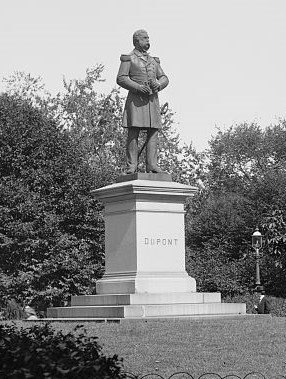
Dupont himself had a long and varied career in the naval service. Born at Berge Point, New Jersey, in 1803, he joined the navy at the age of 12. From there, he worked his way up the promotion ladder, year by year. Dupont was promoted to captain in 1856 and was sent on a mission to China the following year. When the Civil War broke out in 1861, Dupont was in charge of the Philadelphia Navy Yard. He rendered an important service to the Union at this time. During April 1861, Washington, D.C. was dangerously isolated. Virginia, just across the Potomac River, was part of the Confederacy. Maryland was a slave state of as-yet unproven loyalty. Maryland secessionists had cut Washington’s main railroad directly north to Baltimore, and the only telegraph line north, too. Washington itself was defended by only a few hundred soldiers. As reinforcements eventually came in from the North, some worked at repairing the telegraph and the main rail line, and others took a side route from Annapolis. Dupont sent the forces under his command to occupy Annapolis and make the passage easier. Later in 1861, Dupont was put in command of the South Atlantic Blockade Squadron. On November 7, 1861, he and General Thomas W. Sherman captured Port Royal, South Carolina. The following year he was promoted to rear admiral. But then came an unsuccessful ironclad attack on Fort Sumter, at Charleston, South Carolina, after which Dupont was relieved of command, perhaps as a scapegoat. He retired to the family home in Wilmington, Delaware, passing on in 1865. 
The statue was cast in bronze by the sculptor Launt Thompson. It was dedicated before a great crowd on December 20, 1884. The statue showed Dupont standing, holding a pair of binoculars. It was veiled in an American flag, and stars-and-stripes bunting hung from nearby houses. When the statue was unveiled, there was massive cheering. And yet, on February 26, 1917, Congress heeded the request of the Dupont family, including his niece, and passed a law to move the statue to Wilmington, where it stands today. For whatever reason, the family felt the statue in its Washington location had become an embarrassment. The new Dupont memorial was to be a white stone fountain, about 20 feet wide and 20 feet tall. It was designed by Henry Bacon, who also planned the Lincoln Memorial. In the sculpture, the bowl of the fountain is held aloft by three figures representing “The Sea,” “The Wind,” and “The Stars.” They were designed by Daniel Chester French, who did the Lincoln statue inside the Memorial. The fountain was completed in 1921. Today, it is a major Civil War historic site in Washington, D.C., along with a host of other memorials around town. |
Last updated: October 6, 2021
